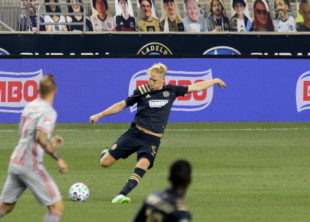Photo: Paul Rudderow
For Union sporting director Ernst Tanner, fit was the theme of last season’s offseason.
Entering his second year of restructuring the Union into a pressing, counterattacking 4-4-2 side, Tanner made a series of moves that swapped out personnel better suited for a 4-2-3-1 for players who fit the club’s new style of play.
A look back at those moves reveals just how successful Tanner was — with the Union’s Supporters’ Shield triumph as proof.
Auston Trusty and Jakob Glesnes
The transactions: Union trade D Auston Trusty to Colorado Rapids in exchange for $300,000 in Targeted Allocation Money (TAM) payable in 2020 and $300,000 in General Allocation Money (GAM) payable in 2021, plus performance bonuses and a sell-on clause. Union sign D Jakob Glesnes from Stromsgodset Toppfotball to a two-year contract with a club option for a third and fourth year using Targeted Allocation Money in exchange for an undisclosed transfer fee.
Tanner started last season with a bang, shipping Homegrown defender Auston Trusty to Colorado for MLS funny money. Trusty played every minute for the Union in the 2018 season, but his form dipped in 2019 and he found himself riding the bench down the stretch. It’s clear enough that things weren’t right behind the scenes, as Trusty made clear in comments after his departure.
Although some eyebrows (including mine) were raised about how quickly Trusty fell from grace, it’s hard to view this move as anything other than a win for Tanner and the Union. Trusty made just five starts this year for Colorado; at least at the moment, it looks like excellent business to sell Trusty at what may end up being the peak of his value. Meanwhile, the Union didn’t miss him at the back, with Mark McKenzie having a best XI season and another Tanner transaction stepping into Trusty’s shoes.
Tanner plowed some of the Trusty TAM into Glesnes, a 25-year-old Norwegian centerback whose look might best be described as “henchman in a James Bond film.” It didn’t take long for Glesnes to endear himself to the Philly faithful, scoring an unreal free kick goal in the second match of the season.
GOOD LORD, WHAT A GOAL!! 🚀@PhilaUnion‘s Jakob Glesnes may have scored one of the goals of the season, and it’s only Week 2(!) 🤯 pic.twitter.com/4wAkMHFYxm
— FOX Soccer (@FOXSoccer) March 9, 2020
(It is literally a crime against humanity that this didn’t win Goal of the Year.)
That unforgettable moment aside, Glesnes settled in nicely alongside McKenzie after rotating with Jack Elliott in the early part of the season, making 17 starts on the year. If, as expected, McKenzie leaves the Union soon, Jim Curtin will feel in good hands with Glesnes anchoring the defense.
Haris Medunjanin, Jose Andres Martinez, and Matej Oravec
The transactions: Union decline to offer a contract to DM Haris Medunjanin. Union sign DM Jose Andres Martinez from Zulia FC in exchange for an undisclosed transfer fee. Union sign DM Matej Oravec from FK DAC 1904 Dunajska Streda to a three-year contract with a club option for a fourth year in exchange for an undisclosed transfer fee.
No position experienced an offseason makeover quite like the base of the Union’s diamond midfield. Although Haris Medunjanin had been a club stalwart for three seasons, his pass-first game didn’t seem to be a natural fit for Tanner’s system, and it wasn’t a huge surprise that he moved on. Medunjanin had a strong season for FC Cincinnati even at age 35, but few Union fans would say that his absence was felt this season.
Tanner brought in two players to fill the spot, and the way those transactions turned out was one of the surprises of 2020. The word around the Union was that 25-year-old Jose “El Brujo” Martinez, an import from the Venezuelan league, was likely to be more of a long-term project, while the 21-year-old Matej Oravec, coming over from Slovakia, would have a bigger role in the 2020 side.
(Compare Tanner’s comments in the press releases announcing the signings: Martinez is “an up-and-coming player whose tenacity and athleticism will bolster our midfield,” while Oravec is “a mobile, aggressive midfielder who can distribute effectively to start our transitions.”)
On the pitch, though, it was a different story. El Brujo entered the starting lineup in the second game of the season and never looked back. The Venezuelan proved himself to be a tenacious tackling machine, covering a ton of ground and breaking up all manner of opposition attacks. And, although he initially seemed always a moment or two away from killing an opponent with a tackle, Martinez managed his aggressiveness better as the season went on. El Brujo’s name is already written in ink on the first starting lineup for next season.
As for Oravec… let’s just say it was a season to forget. The young man made zero appearances for the Union (and Union II) in 2020 as he struggled to find his footing. Even when the Union had to dig deep into their DM depth chart, Oravec was nowhere to be found, finding a converted centerback preferred to him and competing with Homegrown Cole Turner for a reserve role. By the end of the season, Curtin was visibly frustrated with the constant questions about Oravec — it seems clear enough that the coach didn’t think he was ready to play. With two years left on his contract, the club will hope that Oravec settles in this offseason and gets his game together, though a mutual parting may end up in everyone’s best interest. This looks like Tanner’s biggest misfire in an otherwise strong resume in Philadelphia.
Jamiro Monteiro, Marco Fabian, and Fafa Picault
The transaction: Union sign MF Jamiro Monteiro from FC Metz in exchange for a $2 million transfer fee. Union trade winger Fafa Picault to FC Dallas in exchange for $300,000 of 2020 GAM. Union decline contract option on Marco Fabian.
The midfield makeover continued with the Union jettisoning the underperforming Marco Fabian and the ill-fitting Fafa Picault, moves that were best for all parties involved.
Most expected that there would be one more departure, with the Union unlikely to hang on to brilliant loan signing Jamiro Monteiro, with Metz setting a high price tag for the player. In a coup for the Union, Tanner managed to bring back the do-everything midfielder at a reasonable cost — admittedly, the biggest transfer fee in club history.
Did Monteiro live up to the fee? That’s a hard question to unpack. After all, the Union were the best team in the MLS regular season, which is due in part to Monteiro’s steady presence in the midfield. But his output was down over last season (3g/6a vs. 4g/9a), and his game seemed a touch slower — at least to my eyes.
Ultimately, bringing Monteiro back was just as important as a statement of intent as it was for the midfielder’s play on the pitch — a refusal to settle that rewarded the club with its first-ever trophy.


Tanner obviously made some great moves, but missing from your analysis are the moves he didn’t make.
1. Deciding to trust Aaronson at the 10 — brilliant
2. Deciding to ride the strikers he had — horrible, although I think the length of Burke’s absence was a surprise.
3. Not investing in a useful backup keeper — not good, but fortunately we survived this. But he got lucky; had this been a normal year we would have lost Blake for long stretches for Jamaica duty and Bendik wasn’t good enough and Freese probably wasn’t ready, at least until the very end.
This year he needs to replace the outgoing folks and not be so cocky to ride the existing talent, including across the midfield and up front. Add in the need for more depth with Champions League and it’s going to be a busy year.
For what it’s worth, when Freese replaced Blake in 2019 he was much better than the Jamaican. I’d bet he’s more ready than most think, but doesn’t have a path here (a lot like John McCarthy, who seems to be the presumed starter in Miami now).
I’d agree he is there now. I don’t think he was earlier this year, which is why his numbers were so bad.
We still need a third keeper for this year, but he’s a fine second now.
Tanner was playing moneyball with limited funds while retooling the offense based on a different system. It is amazing that he was successful as he was.
.
What I am more interested in is this year’s off-season. He has his system in place, returns many of his starters and presumably has much more funds to work with.
From a note I inserted in my roster spread sheet without noting the date or the source, I think Jose Martinez’s contract was for two years, 2020 & 2021, with one option for a third year, 2022.